最新化学双语教学-中学校本教材(英汉对照)
化学专业无机化学教材及主要参考书

化学专业《无机化学》主要参攻读物配套教材1、北京师大,华中师大,南京师大.无机化学(第四版) .北京:高等教育出版社.2003.1. (面向21世纪课程教材,获优秀教材一等奖,针对高等师范院校编写的教材,理论阐述深度适当,讲解清楚;并注意运用基本理论去解释无机物质的变化规律。
)2、申泮文.近代化学导论.北京:高等教育出版社.2002.1(面向21世纪课程教材,共有四部分: 基本化学原理;溶液平衡和化学分析;元素化学;近代化学热点。
)3 、武汉大学,吉林大学.无机化学(第二版).北京:高等教育出版社.(获国家优秀教材一等奖,高等教育出版社。
内容覆盖面较广,知识点讲解详细,条理清晰,有利于学生自学,有利于学生今后报考综合性大学研究生时,用做复习资料。
)4、傅献彩.大学化学.北京:高等教育出版社.1999.9(化学理科,面向21世纪课程教材,“九五”国家级重点教材,面向21世纪课程教材.将无机化学和化学分析的教学内容融合,上册以化学原理为主,将定量分析纳入化学平衡;下册以元素化学为主。
)5、天津大学.无机化学 (第三版).北京:高等教育出版社.2002.7(面向21世纪课程教材)6、史启祯.无机化学与化学分析(第二版).北京:高等教育出版社.2005.5.(1992年由教育部化学教学指导委员会立项, 列为国家“八五”重点教材.1998年由高教社出版, 2000年被列为国家“面向21世纪课程教材”)7、唐宗熏.中级无机化学.北京:高等教育出版社.2003.(普通高等教育“十五”国家级规划教材,介于无机化学和高等无机化学之间的中级水平的无机化学教材。
系统介绍了现代无机化学所涉及的新理论、新领域、新知识和无机新型化合物。
)8、傅献彩.大学化学.北京:高等教育出版社.(面向21世纪课程教材.将无机化学和化学分析的教学内容融合,上册以化学原理为主,将定量分析纳入化学平衡;下册以元素化学为主)9、申泮文.无机化学. 北京:化学工业出版社. 2002.(面向21世纪课程教材. 编写者均为名校专家,以专题形式撰写无机化学的近代成就与发展现状,各专题选录文献水平为当代国际前沿。
高中化学校本课程教材《绿色化学》
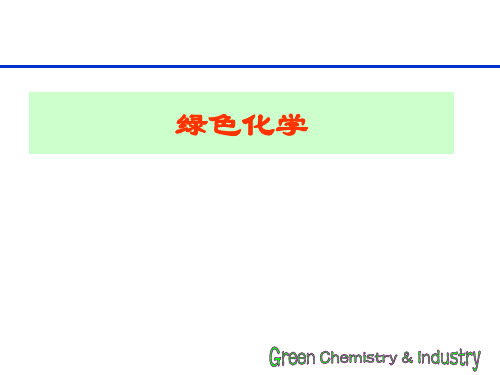
绿色化学化工
1851年,印第安索瓜米西族酋长西雅图—《西雅图宣 言》; 1962年,[美] 蕾切尔· 卡逊—《寂静的春天》; 1972年,罗马俱乐部 [美] 丹尼斯· 米都斯 等—《增长 的极限》; 1972年,[美] 芭芭拉· 沃德,勒内· 杜博斯 —《只有一 个地球》; 1972年,[美] 巴里· 康芒纳—《封闭的循环》; 1975年,[英] 彼得· 辛格—《动物解放》; 1987年,“世界环境与发展委员会”—《我们共同的 未来》; 1991年,[美] 阿尔· 戈尔—《濒临失衡的地球》; 1992年,[美] 艾伦· 杜宁—《多少算够》; 1998年,[瑞士] 苏伦· 埃尔克曼—《工业生态学》。
• 3. 人类活动污染宇宙
人类在太空活动40年来,留在太空的垃圾如废弃卫星、 火箭残骸、爆炸碎片等已满布太空,数以百万计。这些高 速飘游的太空垃圾已成为危险的太空“飘流炸弹”,对在 轨道上运转的太空器造成了严重威胁。 1983年,苏联一颗核动力间谍卫星烧毁,反应堆中的 110磅放射性铀有80%被释放出来,使高层大气中的放射性 最强的铀235含量增加了50%。 由于实验的需要,越来越多的地球生物进入太空。这 些进入太空的生物,在受到强烈紫外线和宇宙射线的照射 后发生突变,可能成为具有强烈毒性的生物。
绿色化学化工
• 3. 《寂静的春天》
1962年,美国科学家卡逊女士发表《寂静的 春天》,以通俗的笔法,提醒世人警惕过度使用农 药的恶果。
《寂静的春天》像是黑暗寂静中的一声呐喊, 唤醒了广大民众。
绿色化学化工
其他环保思想及经典著作
• 《人口原理》—— T.R.马尔萨斯 • • 1798年,T.R.马尔萨斯在《人口原理》一书中 根据资源有限,而人口按几何级数增长的情况,首 次提出人类应控制人口增长的思想。 • 北大校长马寅初教授在中国首次提出实施计划生育 国策。
初中化学双语教案

初中化学双语教案课题:原子结构Lesson Topic: Atomic Structure教学目标 Objectives:1. 理解原子的基本概念和组成。
2. 了解原子的结构及其不同部分的功能。
3. 掌握原子结构的基本模型和构成。
4. 能够描述原子内部的结构和不同部分之间的相互关系。
Teaching Aids: PowerPoint slides, textbook, whiteboard, markers教学过程 Teaching Procedure:Step 1: Introduction to Atoms- Begin the lesson by asking students what they know about atoms. Explain that atoms are the basic building blocks of all matter.- Show a visual representation of an atom on the PowerPoint slides and explain the different parts of an atom (protons, neutrons, electrons).- Discuss the concept of atomic number and atomic mass with the students.Step 2: Atomic Structure- Use the whiteboard to draw a diagram of an atom and label the different parts (protons, neutrons, electrons).- Explain the role of protons, neutrons, and electrons in an atom, and how they are arranged in the atomic structure.- Discuss the significance of the nucleus and electron shells in an atom.Step 3: Atomic Models- Introduce the different models of the atomic structure, such as the Thomson model, Rutherford model, and Bohr model.- Explain how each model contributed to our understanding of the atomic structure and the limitations of each model.Step 4: Activity- Divide the class into small groups and provide each group with a set of materials to build a model of an atom.- Instruct the students to work together to construct the atom model and label the different parts.- Have each group present their atom model to the class and explain how it represents the atomic structure.Step 5: Conclusion- Summarize the key points of the lesson and review the basic concepts of atomic structure with the students.- Encourage students to ask questions and clarify any misunderstandings they may have about atoms.Homework:- Ask students to research the contributions of different scientists to the development of atomic theory and write a short summary of their findings.教学反思 Teaching Reflection:本节课的教学目标是帮助学生理解原子的基本结构和组成,掌握原子结构的基本模型和构成。
【校本教材】高中化学校本课程教材:化学与食品化学

校本教材名称:化学与食品化学高中高中化学实施方案一、指导思想认真贯彻《基础教育课程改革纲要》的精神,结合我校“明理”教育特色学校创建,学校坚持以一切为了学生的发展为本,以兴趣性、拓展性为主,发展学生个性为主要目标,让课程适应学生的需要,有效促进学生的健康全面的发展。
根据学校的办学目标,充分利用学校现有的教学特色以及丰富的资源优势,认真做好校本课程的开发与研究,带动学校师资队伍建设与课程开发、管理、评价以及教学资源开发等方面的和谐发展。
充分利用学校的文化积淀、优厚的学校资源以及朱子故里丰富的图书资源与社区文化资源,引导学生继承、体悟和践履朱子理学中的伦理内蕴精髓,实现弘扬传统与培养学生社会主义核心价值观结合,打造“明理”教育特色学校,积极做好化学课校本课程的研究开发与实施工作。
二、实施目标要实现“以培养学生科学素养为主旨,激发学生学习化学的兴趣,帮助学生了解科学探究的基本过程和方法,培养学生科学探究能力”这一课程目标,必须在利用教材这一课程资源的同时充分开发化学校本课程以弥补教材的不足,推动素质教育的不断深化。
通过本次校本课程的研究学习,让同学们了解“生活中的化学”,在现实生活中,化学与之息息相关,可以说,我们每天都接触化学的有关内容,如衣、食、住、行都与化学有关,人们要创造美好幸福的生活是离不开化学的。
三、课程内容1.绿色化学——一种新的化学理念。
2.酸雨。
3.居室污染——生命健康的隐形杀手。
4.化学废旧电池的利用。
5.日用洗涤剂和人类健康。
6 .酒与健康。
7. 氢能——人类发展的历史性选择。
8. 环境。
四、开发原则本校本课程的开发设计的指导思想主要是依据新课标的教学理念,进一步提高学生的科学素养为宗旨,着眼于学生未来的发展,兼顾学生志趣与潜能的差异和发展的需要,以提高学生的科学素养为宗旨,激发学生学习化学的兴趣,尊重个性发展;帮助学生在已经获得知识的基础上解决问题的技能和方法,提高学生的科学探究能力;也培养学生的合作精神,提高学生的实践能力。
初中化学部分化学名词中英文对照归纳

litmus
高分子化合物
polymer
酶
enzyme
塑料
plastic
淀粉
starch
合成纤维
Synthetic material
油脂
fats and oils
合成橡胶
Synthetic rubber
蛋白质
protein
可降解塑料
Degradable plastics
氨基酸
amion acid
糖类
附:部分化学名词中英文对照化学名词的归纳
(1)化学反应类型名词中英文对照
中文
英文
氧化反应
oxidation reaction
还原反应
reduction reaction
化合反应
combination reaction
分解反应
decomposition reaction
置换反应
displacement reaction
初中化学部分化学名词中英文对照归纳
人教版九年级化学教材中共有化学名词中英文对照名词103个,可以将其分类整理归纳,形成系统性。在整理的过程中发现许多的名词很有规律。如化学反应类型中:氧化反应 oxidation reaction,还原反应reduction reaction,它们是“氧化oxidation”+“反应reaction”的形式。
复分解反应
uble decomposition reaction
(2)常见金属的名称中英文对照
铝
aluminum
铁
iron
铜
copper
钛
titanium
(3)常见有机物的名称中英文对照
有机化合物
麦克米伦中学化学双语教材解读
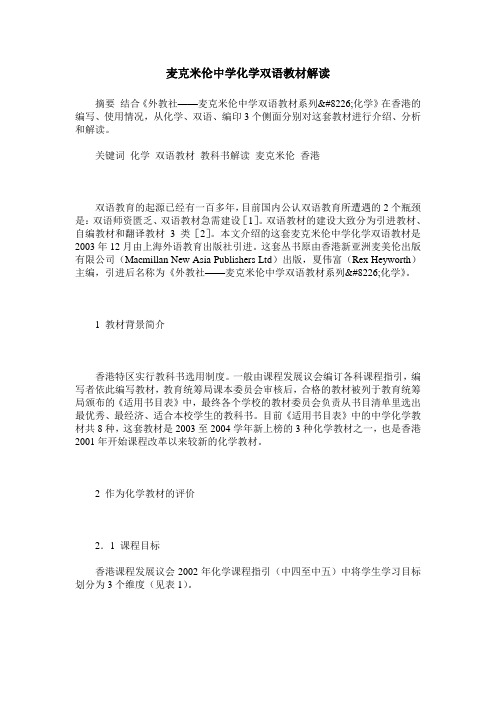
麦克米伦中学化学双语教材解读摘要结合《外教社——麦克米伦中学双语教材系列•化学》在香港的编写、使用情况,从化学、双语、编印3个侧面分别对这套教材进行介绍、分析和解读。
关键词化学双语教材教科书解读麦克米伦香港双语教育的起源已经有一百多年,目前国内公认双语教育所遭遇的2个瓶颈是:双语师资匮乏、双语教材急需建设[1]。
双语教材的建设大致分为引进教材、自编教材和翻译教材3类[2]。
本文介绍的这套麦克米伦中学化学双语教材是2003年12月由上海外语教育出版社引进。
这套丛书原由香港新亚洲麦美伦出版有限公司(Macmillan New Asia Publishers Ltd)出版,夏伟富(Rex Heyworth)主编,引进后名称为《外教社——麦克米伦中学双语教材系列•化学》。
1 教材背景简介香港特区实行教科书选用制度。
一般由课程发展议会编订各科课程指引,编写者依此编写教材,教育统筹局课本委员会审核后,合格的教材被列于教育统筹局颁布的《适用书目表》中,最终各个学校的教材委员会负责从书目清单里选出最优秀、最经济、适合本校学生的教科书。
目前《适用书目表》中的中学化学教材共8种,这套教材是2003至2004学年新上榜的3种化学教材之一,也是香港2001年开始课程改革以来较新的化学教材。
2 作为化学教材的评价2.1 课程目标香港课程发展议会2002年化学课程指引(中四至中五)中将学生学习目标划分为3个维度(见表1)。
2.2 教材内容2.2.1 结构和章节这套教材共4册8本,每册学生用书配套1本教师用书(分别编号为1A、1B、2A、2B),供高中2年(4个学期)使用。
每册的结构大体可分为前言、课文和附录3大部分。
前言包括各项出版说明、目录、致谢以及如何用好本书的说明。
课文(4册总计)共8篇22章。
周课时4节,每节40 min,共192课时(128 h)来完成整个课程。
教材章节结构第一册1A第一篇物质的基础1元素;2原子结构和周期表;3化合物和混合物;4化学键;5结构、化学键和性质;第二篇常见金属6常见金属和合金的用途;7金属的活泼性;8金属的腐蚀和保护;第二册1B第三篇化学电池和电解作用9化学电池;10氧化还原反应;11电解;第四篇常见的酸和碱12常见的酸和碱;13容量分析;第三册2A第五篇化石燃料14化石燃料的用途;15燃料的燃烧;16使用燃料所引致的环境问题;第四册2B第六篇来自石油的重要产品17塑胶;18烷醇;19清洁剂;第七篇重要的工业产品20氮肥;21漂白剂;第八篇化学药品与健康22化学药品与健康。
化学课程英文名称对照表
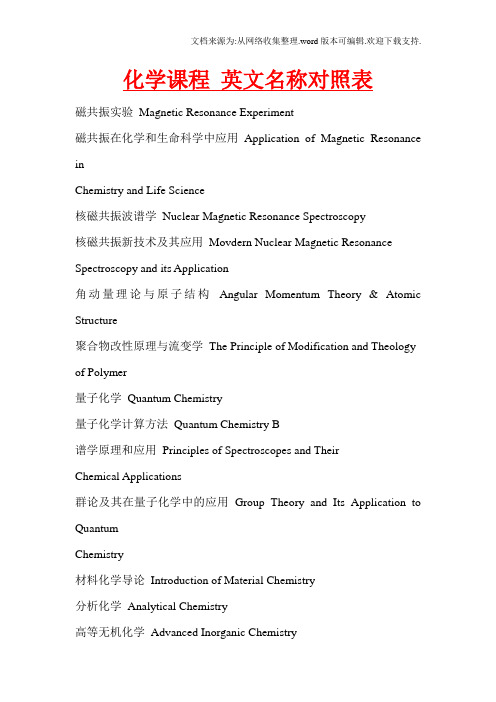
化学课程英文名称对照表磁共振实验Magnetic Resonance Experiment磁共振在化学和生命科学中应用Application of Magnetic Resonance inChemistry and Life Science核磁共振波谱学Nuclear Magnetic Resonance Spectroscopy核磁共振新技术及其应用Movdern Nuclear Magnetic Resonance Spectroscopy and its Application角动量理论与原子结构Angular Momentum Theory & Atomic Structure聚合物改性原理与流变学The Principle of Modification and Theology of Polymer量子化学Quantum Chemistry量子化学计算方法Quantum Chemistry B谱学原理和应用Principles of Spectroscopes and TheirChemical Applications群论及其在量子化学中的应用Group Theory and Its Application to QuantumChemistry材料化学导论Introduction of Material Chemistry分析化学Analytical Chemistry高等无机化学Advanced Inorganic Chemistry高等有机化学Advanced Organic Chemistry结构化学Structural Chemistry结构化学Structural Chemistry无机化学Inorganic Chemistry无机化学Inorganic Chemistry无机及分析化学Inorganic and Analytic Chemistry无机及分析化学Inorganic and Analytic Chemistry物理化学Physical Chemistry物理化学Physical Chemistry物理化学Physical Chemistry物理化学Physical Chemistry物理化学Physical Chemistry仪器分析Instrumental Analysis仪器分析Instrumental Analysis仪器分析Instrumental Analysis有机化学Organic Chemistry有机化学Organic Chemistry有机化学Organic Chemistry有机化学Organic Chemistry量子无机化学Quantum Inorganic Chemistry量子有机化学Quantum Organic Chemistry植物生长与发育的化学调整Chemical Adjustment of Plant's Growth分析化学Analysis Chemistry分析化学及实验Analytical Chemistry and Experiment分析化学实验Experiment of Analytical Chemistry计算机基础(C语言) Computer Basis C Language普通物理学General Physics无机化学实验Experiment in Inorganic Chemistry无机化学实验Experiment in Inorganic Chemistry无机化学实验Experiment in Inorganic Chemistry无机化学实验Experiment in inorganic Chemistry物理化学实验Experiment of Physical Chemistry物理化学实验Experiment of Physical Chemistry物理化学实验Experiment of Physical Chemistry物理化学实验Experiment of Physical Chemistry仪器分析实验Experiments of Instrument Analysis有机化学实验Organic Chemistry Experiment有机化学实验Organic Chemistry Experiment有机过渡金属化学Organotransition Metal ChemistryX射线晶体结构分析Crystal Structure Analysis by X-ray电分析化学实验Experiment in Electroanalytical Chemistry分子发光分析Molecular Luminescence Analysis分子发光分析进展Advances in Molecular Luminescence Analysis 高分子材料化学Polymer Chemistry高分子材料研究方法Research Methods of Polymeric Materials高分子合成与分子设计Polymeric Synthesis and Molecular Design 高分子化学实验Experiment of Polymeric Chemistry高分子物理实验Experiment of Polymer Physics化学分离法Chemical Method of Separation化学计量学Chemometrics化学统计力学和应用Statistical Mechanics and Applications in Chemistry化学文献Chemical Document化学文献Scientific Literature in Chemistry化学文献Chemical Literature化学文献Chemical Literature Searching金属有机高聚物Metallic Organic Polymer近代电分析Electroanalytical Chemistry近代分离分析Analytical Separation and Chromatography近代光分析Modern Light Analysis配位化学* Coordination Chemistry配位化学选读Selective Topics on Modern Coordination Chemistry无机材料化学The Chemistry of Inorganic Materials无机材料实验Experiment in Inorganic Materials无机材料物理Polymeric Materials Physics无机合成与研究方法Synthesis and Research Methods for Inorganic Substance无机物研究法Research Methods of Inorganic Substance 无机元素化学Inorganic Elements Chemistry物化专门化实验Physical Chemistry Experiment物化专门化实验Physical Chemistry Experiment物化专门化实验Physical Chemistry Experiment物理有机化学Physical Organic Chemistry仪器分析选读Advanced Instrumentation in Chemistry有机分析Analysis and Structure Determination of Organic Compounds有机分析实验Organic Analytic Experiment有机合成Organic Synthesis有机合成化学Synthetic Organic Chemistry有机合成实验Organic Synthesis Experiment有机化学文献Document of Organic Chemistry专业英语(分析) Scientific English on Analytical Chemistry 专业英语(无机) Specialty English专业英语(有机) Subject English专业英语(物化) Chemistry English生物无机化学Bioinorganic Chemistry生物无机化学Bioinorganic Chemistry材料工程导论Introduction of Materials Engineering 环境分析化学Environmental Analytical Chemistry 界面化学Surface Chemistry应用电化学Applied Electronic chemistry荧光分析法Flueremetry普通化学General Chemistry普通化学实验General Chemistry Experiments。
化学校本课程教材

化学校本课程教材趣味化学实验课程说明你看见过胶冻能燃烧、无水有冰袋、消字密无痕、水下百花开等现象吗?你知道这是为什么吗?你想亲自来动手试一试吗?如果答案是肯定的,那么请你走进《趣味化学实验》这个小天地吧!在这些富有情趣的化学实验中,你不仅能复习巩固化学知识,而且能提高学习化学的兴趣和热情,丰富课外生活,锻炼我们的动手能力,最终增进化学科学素养。
《趣味化学实验》课程安排为十个课时的内容,涵盖了贴近学生生活以及现实所学内容的简单实验,以让学生更多了解化学在生活中的应用。
每个课时内容大致分为:背景知识、实验原理、实验用品、实验步骤、问题思考、相关以及扩展实验几大部分。
目录趣味化学实验一:制作“叶脉书签” (3)趣味化学实验二:模拟酸雨腐蚀岩石的过程 (5)趣味化学实验三:自制酸碱指示剂 (6)趣味化学实验四:化学“冰箱”与冰袋 (8)趣味化学实验五:指纹鉴定以及检验加碘食盐中的碘元素 (11)趣味化学实验六:水下公园 (14)趣味化学实验七:豆腐中钙质的检验 (16)趣味化学实验八:食物中常见元素的测定 (20)趣味化学实验九:铝器表面刻字以及制备可燃的“胶冻” (22)趣味化学实验十:合成香精 (24)趣味化学实验十一:消字灵的制作 (29)趣味化学实验一:制作“叶脉书签”制作原理:叶片的叶肉部分容易腐烂降解,而叶脉非常坚韧,能构成各种形状比如网状、扇形、弧形等结构,以支持叶片。
选取具网状脉的植物叶片,用氢氧化钠等碱溶液加热煮沸,可以水解掉叶肉等部分,仅剩下网状脉,再利用过氧化氢的强氧化性将叶脉漂白,一件精美的叶脉书签便制作成功了。
工具材料:(1)5-10%的氢氧化钠溶液,5%的过氧化氢溶液;(2)电热套、烧杯(多个)、瓷盘、旧牙刷、镊子、水彩色;(3)采摘新鲜的具网状脉的植物叶子,如白玉兰、杨树、白蜡等。
制作步骤:(1)实验前采摘新鲜的树叶(以白玉兰叶为佳),落叶也可择优选用,应注意采摘树叶时要爱护植物;(2)用电热套加热氢氧化钠溶液,直至沸腾;(3)选5—10片大小适合的树叶放进煮沸的碱液中,要不停地将叶子摁到水下,直至沸腾,保持沸腾10分钟;(4)不时地用镊子拿出叶子,用手感觉叶肉是否煮烂;(5)在瓷盘里加适量水,将已煮烂的叶片放到其中,用旧牙刷刷叶肉,刷时先刷正面,按从左向右,从叶柄向叶尖,从主脉向侧脉有序地刷,直至刷掉叶肉;再将叶片翻转,用同样的方法刷,直至只剩下网状脉;(6)将叶脉放到盛清水的烧杯中,洗去残渍;(7)将洗尽的叶脉放到盛有5%的过氧化氢溶液中,放置24小时;(8)24小时后,叶脉便被漂白,从过氧化氢溶液中取出叶脉,放到标本纸中压干、压展;(9)将红水彩放到培养皿中,用水稀释3倍,并用毛笔刷到叶脉上,然后晾干;(10)将已涂色的叶脉标本进行压膜,各人还可根据自己的爱好进行艺术处理,这样一个精美的叶脉书签就制作成功了。
化学课程英文名称对照表
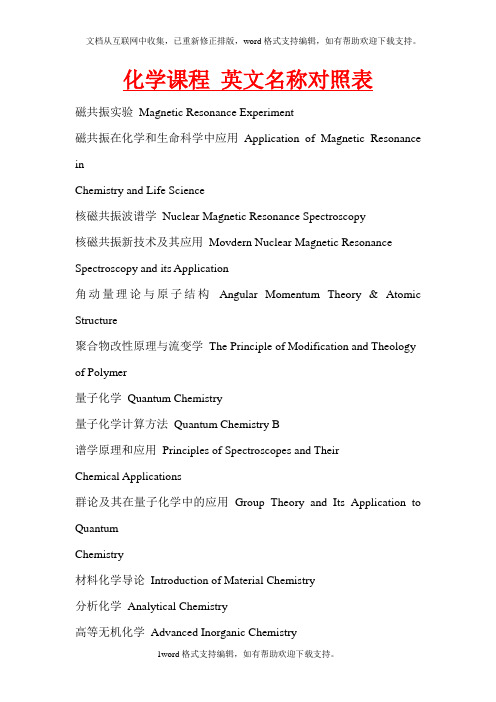
化学课程英文名称对照表磁共振实验Magnetic Resonance Experiment磁共振在化学和生命科学中应用Application of Magnetic Resonance inChemistry and Life Science核磁共振波谱学Nuclear Magnetic Resonance Spectroscopy核磁共振新技术及其应用Movdern Nuclear Magnetic Resonance Spectroscopy and its Application角动量理论与原子结构Angular Momentum Theory & Atomic Structure聚合物改性原理与流变学The Principle of Modification and Theology of Polymer量子化学Quantum Chemistry量子化学计算方法Quantum Chemistry B谱学原理和应用Principles of Spectroscopes and TheirChemical Applications群论及其在量子化学中的应用Group Theory and Its Application to QuantumChemistry材料化学导论Introduction of Material Chemistry分析化学Analytical Chemistry高等无机化学Advanced Inorganic Chemistry高等有机化学Advanced Organic Chemistry结构化学Structural Chemistry结构化学Structural Chemistry无机化学Inorganic Chemistry无机化学Inorganic Chemistry无机及分析化学Inorganic and Analytic Chemistry无机及分析化学Inorganic and Analytic Chemistry物理化学Physical Chemistry物理化学Physical Chemistry物理化学Physical Chemistry物理化学Physical Chemistry物理化学Physical Chemistry仪器分析Instrumental Analysis仪器分析Instrumental Analysis仪器分析Instrumental Analysis有机化学Organic Chemistry有机化学Organic Chemistry有机化学Organic Chemistry有机化学Organic Chemistry量子无机化学Quantum Inorganic Chemistry量子有机化学Quantum Organic Chemistry植物生长与发育的化学调整Chemical Adjustment of Plant's Growth分析化学Analysis Chemistry分析化学及实验Analytical Chemistry and Experiment分析化学实验Experiment of Analytical Chemistry计算机基础(C语言) Computer Basis C Language普通物理学General Physics无机化学实验Experiment in Inorganic Chemistry无机化学实验Experiment in Inorganic Chemistry无机化学实验Experiment in Inorganic Chemistry无机化学实验Experiment in inorganic Chemistry物理化学实验Experiment of Physical Chemistry物理化学实验Experiment of Physical Chemistry物理化学实验Experiment of Physical Chemistry物理化学实验Experiment of Physical Chemistry仪器分析实验Experiments of Instrument Analysis有机化学实验Organic Chemistry Experiment有机化学实验Organic Chemistry Experiment有机过渡金属化学Organotransition Metal ChemistryX射线晶体结构分析Crystal Structure Analysis by X-ray电分析化学实验Experiment in Electroanalytical Chemistry分子发光分析Molecular Luminescence Analysis分子发光分析进展Advances in Molecular Luminescence Analysis 高分子材料化学Polymer Chemistry高分子材料研究方法Research Methods of Polymeric Materials高分子合成与分子设计Polymeric Synthesis and Molecular Design 高分子化学实验Experiment of Polymeric Chemistry高分子物理实验Experiment of Polymer Physics化学分离法Chemical Method of Separation化学计量学Chemometrics化学统计力学和应用Statistical Mechanics and Applications in Chemistry化学文献Chemical Document化学文献Scientific Literature in Chemistry化学文献Chemical Literature化学文献Chemical Literature Searching金属有机高聚物Metallic Organic Polymer近代电分析Electroanalytical Chemistry近代分离分析Analytical Separation and Chromatography近代光分析Modern Light Analysis配位化学* Coordination Chemistry配位化学选读Selective Topics on Modern Coordination Chemistry无机材料化学The Chemistry of Inorganic Materials无机材料实验Experiment in Inorganic Materials无机材料物理Polymeric Materials Physics无机合成与研究方法Synthesis and Research Methods for Inorganic Substance无机物研究法Research Methods of Inorganic Substance 无机元素化学Inorganic Elements Chemistry物化专门化实验Physical Chemistry Experiment物化专门化实验Physical Chemistry Experiment物化专门化实验Physical Chemistry Experiment物理有机化学Physical Organic Chemistry仪器分析选读Advanced Instrumentation in Chemistry有机分析Analysis and Structure Determination of Organic Compounds有机分析实验Organic Analytic Experiment有机合成Organic Synthesis有机合成化学Synthetic Organic Chemistry有机合成实验Organic Synthesis Experiment有机化学文献Document of Organic Chemistry专业英语(分析) Scientific English on Analytical Chemistry 专业英语(无机) Specialty English专业英语(有机) Subject English专业英语(物化) Chemistry English生物无机化学Bioinorganic Chemistry生物无机化学Bioinorganic Chemistry材料工程导论Introduction of Materials Engineering 环境分析化学Environmental Analytical Chemistry 界面化学Surface Chemistry应用电化学Applied Electronic chemistry荧光分析法Flueremetry普通化学General Chemistry普通化学实验General Chemistry Experiments。
化学专业课程中英文对照

本文由wkai2003贡献doc文档可能在WAP端浏览体验不佳。
建议您优先选择TXT,或下载源文件到本机查看。
化学专业课程中英文对照,已搜索,无重复! 普通化学 General Chemistry 分析化学Analytical Chemistry 有机化学 Organic Chemistry 物理化学 Physical Chemistry 谱学导论 Introducton of Spectroscopy 无机化学 Inorganic Chemistry 普通化学和分析化学实验 Experiments of General and Analytical Chemistry 现在基础化学 The Principle of Mordern Chemistry 现在基础化学实验 Experiments of Modern Fundamental Chemistry 有机化学实验 Experiments of Organic Chemistry 仪器分析和物理化学实验 Experiments of Instrumental Analysis and PhysicalChemistry 合成化学实验 Experiments of Synthetic Chemistry 现代化学专题 Topic of Modern Chemistry 化学综合实验 Experiments of Comprehensive Chemistry 化工原理 Principle of Chemical Engineering 化工原理实验Experiments of Chemical Engineering 应用化学实验 Experiments of Applied Chemistry 无机合成化学Synthetic Inorganic Chemistry 近代分析化学Modern Analytical Chemistry 分离分析化学Separation Analytical Chemistry 有机化合物波谱鉴定Spectrum Identification of Organic Compounds 有机合成及反应机理 Organic Synthesis and Mechanics 化学进展Progress in Chemistry 化学反应工程Chemical Reaction Engineering 应用电化学 Applied Electrochemistry工业催化Industrial Catalysis 环境化学Environmental Chemistry 环境监测Environmental Monitoring 化学科技英语 Scientific English for Chemistry 数理方法在化学中的应用 Mathematical Statistics for Chemistry 化工制图 Chemical Engineering Cartography 计算机与化学测量实验 Computer and Chemical Measurement 化学信息学Chemoinformatics or Chemical Informatics 应用化学专题 Special Topics in Applied Chemistry 化工装置常用词汇 1 一概论 introduction 方案(建议书) proposal 可行性研究 feasibility study 方案设计 concept design 工艺设计 process design 基础设计basic design 详细设计 detail design 开工会议 kick-off meeting 审核会议 review meeting 外商投资 foreign investment 中外合资 joint venture 中外合营 joint venture 补偿贸易 compensation trade 合同合同附件 contract 卖方 vendor 买方 buyer 顾客client 承包商 contractor 工程公司 company 供应范围 scope of supply 生产范围production scope 生产能力 production capacity 项目 project 界区 battery limit 装置plant 公用工程utilities 工艺流程图process flow diagram 工艺流程方块图process block diagram 管道及仪表流程图 piping and instrument drawing 物料及热量平衡图 mass & heat balance diagram 蒸汽及冷凝水平衡图 steam & condensate balance diagram 设备布置图 equipment layout 设备表 equipment list 成品(产品) product(final product) 副产品 by-product 原料 raw-material 设计基础数据basic data for design 技术数据 technical data 数据表 data sheet 设计文件 design document 设计规定 design regulation 现场服务 site service 项目变更 project change 用户变更 client change 消耗定额 consumption quota 技术转让 technical transfer 技术知识technical know-how 牋牋牋牋technical knowledge 技术保证technical guarantee 咨询服务 consultative services 技术服务 technical services 工作地点location 施工现场 construction field 报价 quotation 标书 bidding book 公司利润company profit 固定价合同 fixed price contract 固定单价合同 fixed unit price contract 成本加酬金合同 cost plus award fee contract 定金 mobilization 银行保证书bank guarantee letter 保留金 retention 所得税 income taxes 特别承包人税 special contractor's taxes 城市和市政税 city and municipal taxes 工作手册 work manual 工作流程图 work flow diagram 质量保证程序 QA/QC procedures 采购计划 procurement plan 施工计划 construction plan 施工进度 construction schedule 项目实施计划 project execution plan 项目协调程序 project coordination procedure项目总进度计划 project master schedule 设计网络计划 engineering network logic 项目质量保证 project quality assurance 项目质量控制 project quality control 采购procurement 采购周期 procurement period 会签 the squad check 计算书 calculation sheets 询价inquiry 检验inspection 运输transportation 开车start up / commission 验收 inspection & acceptance 校核 check 审核 review 审定 approve 版次version 部门 department 专业 specialty 项目号 project number 图号 drawing number 目录 contents 序言 foreword 章 chapter 节 section 项 item MR material requisition SPEC engineering specification DATA SHEET(技术表) technical data sheet TBA(技术评标) technical bid analysis PDP preliminary design package PM (项目经理) project manager LDE(专业负责人lead discipline engineer MRQ(材料询价单) Material requisition for quotation MRP(材料采购单) material requisition for purchase BEP(基础工程设计包) basic engineering package P&ID(管道及仪表流程图) piping and instrument drawing(diagram) PFD process flow diagram NNF normally no flow FO failure open FC failure close C/S/A civil/structure/architecture DDP(详细设计阶段) detail design phase化工装置词汇二. 工艺流程连续过程 continuous process 间歇过程 batch process 工艺叙述process description 工艺特点process feature 操作operation 反应reaction 副反应 side reaction 絮凝 flocculation 浮洗 flotation 倾析 decantation 催化反应catalytical reaction 萃取extraction 中和neutralization 水解hydrolysis 过滤filtration 干燥drying 还原reduction 氧化oxidation 氢化hydrogenation 分解decomposition 离解dissociation 合成synthetics 吸收absorption 吸附 adsorption 解吸 desorption 结晶 crystallization 溶解 solution 调节 modulate 控制 control 悬浮 suspension 循环 circulation 再生 regeneration 再活化 reactivation 沥取 leaching 破碎 crushing 煅烧 caloination 沉降 sedimentation 沉淀 precipitation 气化 gasification 冷冻 refrigeration固化,结晶 solidification 包装 package 升华 sublimation 燃烧 combustion 引烧ignition 蒸馏 distillation 碳化 carbonization 压缩 compression 三,化学物质及特性固体 solid 液体 liquid 气体 gas 化合物 compound 混合物 mixture 粉 powder 片状粉未 flake 小粒 granule 结晶 crystal 乳化物 emulsion 氧化物 oxidizing agent 还原剂reducing agent 有机物 organic material 真空 vacuum 母液 master liquor 富液 rich liquor 贫液 lean liquor 萃出物 extract 萃余物 raffinate 絮凝剂 flocculants 冷冻盐水 brine 酸度 acidity 浓度 concentration 碱度 alkalinity 溶解度 solubility 凝固点solidificalion point 沸点boiling point 熔点melting point 蒸发率evaporation rate 粘度 viscosity 吸水的 water absorbent(a) 无水的 anhydrous(a) 外观 appearance 无色的 colorless(a)透明的transparent(a) 半透明的translucent 密度density 比重specific gravity 催化剂catalyst 燃烧combustion 引燃ignition 自然点self-ignition temperature 可燃气体combustible gas 可燃液体inflammable liquid 易燃液体volatile liquid 爆炸混合物explosive mixture 爆炸性环境explosive atmosphere(environment) 爆炸极限 explosive concentration limit 废水 waste water 废液waste liquid 废气off-gas 噪声noise pollution 成分composition 挠度deflection 力和力矩force and moment 弯矩bending moment 应力-应变曲线stress-strain diagram 百分比 percentage 环境温度 ambient temperature 工作温度operating 设计温度 design temperature(pressure) 相对湿度 RH=relative humidity 油渣,淤泥 sludge 杂质 impurity 四,化工设备泵 pump 轴流泵 axial flow pump 真空泵vacuum pump 屏蔽泵 canned pump 柱塞泵 plunger pump 涡轮泵 turbine pump 涡流泵vortex pump 离心泵 centrifugal pump 喷射泵 jet pump 转子泵 rotary pump 管道泵inline pump 双作用往复泵 double action reciprocating pump计量泵 metering pump 深井泵 deep well pump 齿轮泵 gear pump 手摇泵 hand(wobble) pump 螺杆泵 screw (spiral) pump 潜水泵 submersible pump 斜转子泵 inclined rotor pump 封闭式电磁泵 hermetically sealed magnetic drive pump 气升泵 air-lift-pump 轴承 bearing 叶轮 impeller 虹吸管 siphon 高压容器 high pressure vessel 焚化炉incinerator 火焰清除器 flame arrester 工业炉 furnace 烧嘴 burner 锅炉 boiler 回转窑 rotary kiln 加热器 heater 电加热器 electric heater 冷却器 cooler 冷凝器condenser 换热器 heat exchanger 反应器 reactor 蒸馏釜 still 搅拌器 agitator 混合器 mixer 静态混合器 static mixers 管道混合器 line mixers 混合槽 mixing tanks 破碎机 crusher 磨碎机 grinder 研磨机 pulverizer 球磨机 ballmill 过滤器 filter 分离器separator 干燥器drier 翅片fins 烟囱stack 火炬flare 筛子screen 煅烧窑calciner 倾析器 decanter蒸发器 evaporator 再沸器 reboiler 萃取器 extractor 离心机 centrifuger 吸附(收)器adsorber 结晶器crystallizer 电解槽electrolyzer 电除尘器electric precipitator 洗涤器 scrubber 消石灰器 slaker 料仓 bin 料斗 hopper 加料器 feeder 增稠器 thickener 澄清器 clarifier 分级器 classifier 浮洗器 flocculator 废液池sump 喷射器 ejector 喷头 sprayer 成套设备 package unit 仪器设备 apparatus 附属设备 accessory 旋转式压缩机 rotary compressor 往复式压缩机 reciprocating compressor 水环式压缩机 nash compressor 螺杆式压缩机 helical screw compressor 离心式压缩机centrifugal compressor 多级压缩机 mutiple stages compressor 固定床反应器 fixed bed reactor 流化床反应器 fluidized bed reactor 管式反应器 tubular reactor 列管式换热器tubular heat exchanger 螺旋板式换热器spiral plate heat exchanger 萃取塔extraction column 板式塔 plate column 填料塔 packed column 洗涤塔 scrubber 吸收塔absorber 冷却塔 cooling tower 精馏塔 fractionating tower 汽提塔 stripper 再生塔regenerator 造粒塔 prill tower塔附件 tower accessories 液体分配(布)器 liquid distributor 填料支持板 support plate 定距管 spacer 降液管 downcomer 升气管 chimney 顶(底)层塔盘 top (bottom) tray 挡板 baffle 抽出口 draw nozzle 溢流堰 weir 泡罩 bubble cap 筛板 sieve plate 浮阀 float valve 除沫器 demister pad 塔裙座 skirt 椭圆封头 elliptical head 高位槽head tank 中间槽 intermediate tank 加料槽 feed tank 补给槽 make-up tank 计量槽measuring tank 电解槽 cell 溜槽 chute 收集槽 collecting tank 液滴分离器 knockout drum 稀释罐 thinning tank 缓冲罐 surge drum 回流罐 reflux drum 闪蒸罐 flash drum 浮顶罐 floating roof tank 内浮顶罐 covered floating roof tank 球罐 spheroid 气柜gas holder 湿式气柜 wet gas-holder 干式气柜 dry gas-holder 螺旋式气柜 helical gas-holder 星型放料器,旋转阀 rotary valve 抽滤器 mutche filter 压滤器 filter press 压滤机 pressure filter 板框压滤器 plate-and-fram filter press 转鼓过滤器rotary drum filter 带式过滤器 belt filter 翻盘式过滤器袋滤器 bag filter 旋风分离器 cyclone separator 盘式干燥箱 compartment traydrier 真空干燥器 vacuum drier 隧道式干燥器 tunnel drier 回转干燥器 rotary drier 穿流循环干燥器through circulation drier 喷雾干燥器spray drier 气流干燥器pneumatic conveyor drier 圆盘式加料器 dish feeder 螺旋式加料器 screw feeder 颚式破碎机 jaw crusher 回转破碎机 gyratory crusher 滚洞破碎机 roll crusher 锤式破碎机hammer crusher 冲击破碎机 rotor impact breaker 气流喷射粉碎机 jet pulverizer 棍磨机 rod mill 雷蒙机 raymond mill 锤磨机 hammer mill 辊磨机 roller mill 振动筛vibrating screen 回转筛 rotary screen 风机 fan 罗茨鼓风机 root's blower 起重机crane 桥式起重机 bridge crane 电动葫芦 motor hoist 发电机 generator 电动机 motor 汽轮机 steam turbine 五,管道工程 piping engineering 1 阀门 valve 阀杆 stem 内螺纹阀杆 inside screw 阀座 valve seat (body seat) 阀座环,密封圈 sealing ring 阀芯(包括密封圈,杆等)trim 阀盘 disc 阀体 body 阀盖 bonnet 手轮 hand wheel 手柄 hand level (handle)压盖 gland 闸阀 gate valve 平行双闸板 double disc parallel seat 楔形单闸板split wedge 截止阀 globe valve 节流阀 throttle valve 针阀 needle valve 角阀(角式截止阀)angle valve Y 型阀(截止阀)Y-valve(Y-body globe valve) 球阀 ball valve 三通球阀 3-way ball valve 蝶阀 butterfly valve 对夹式(薄片型)wafer type 偏心阀板蝶阀offset disc (eccentric) butterfly valve 斜阀盘蝶阀 canted disc butterfly valve 连杆式蝶阀 link butterfly valve 止回式蝶阀 combined non-return butterfly valve 柱塞阀 piston type valve 旋塞阀 plug valve 三通旋塞阀 three-way plug valve 四通旋塞阀four-way plug valve 旋塞 cock 衬套旋塞 sleeve cock 隔膜阀 diaphragm valve 橡胶衬里隔膜阀 rubber lined diaphragm valve 直通式隔膜阀 straight way diaphragm valve 夹紧式胶管阀 pinch valve 止回阀 check valve 升降式止回阀 lift check valve 旋启式止回阀 swing check valve 落球式止回阀 ball check valve 弹簧球式止回阀 spring ball check valve 底阀 foot valve 切断式止回阀 stop check valve 活塞式止回阀 piston check valve 翻板止回阀 flap check valve 蝶式止回阀 butterfly check valve 安全泄气阀 safety[SV] 安全泄放阀 relief valve[RV] 安全泄压阀 safety relief valve 杠杆重锤式 lever and weight type 罐底排污阀 flush-bottom tank valve 波纹管密封阀 bellow sealed valve 电磁阀 solenoid (operated) valve电动阀 electrically(electric-motor)operated valve 气动阀 pneumatic operated valve 低温用阀cryogenic service valve 蒸汽疏水阀steam trap 机械式疏水阀mechanical trap 浮桶式疏水阀 open (top) bucket trap 浮球式疏水阀 float trap 倒吊桶式疏水阀 inverted bucket trap 自由浮球式疏水阀 loose float trap 恒温式疏水阀thermostatic trap 压力平衡式恒温疏水阀 balanced pressure thermostatic trap 热动力式疏水阀 thermodynamic trap 脉冲式蒸汽疏水阀 impulse steam trap 放汽阀(自动放汽阀)(automatic) air vent valve 换向阀 diverting (reversing) valve 呼吸阀 breather valve 减压阀 pressure reducing valve 控制阀 control valve 执行机构 actuator 差压调节阀 differential pressure regulating valve 切断阀 block (shut-off, stop) valve 调节阀 regulating valve 快开阀 quick opening valve 快闭阀 quick closing valve 隔断阀 isolating valve 三通阀 three way valve 夹套阀 jacketed valve 非旋转式阀non-rotary valve 2 管子,管件,法兰管子 pipe(按标准制造的配管用管) tube(不按标准规格制造的其它用管) 钢管 steel pipe 铸铁管 cast iron pipe 衬里管 lined pipe 复合管clad pipe 碳钢管carbon steel[C.S.]pipe 合金钢管alloy steel pipe 不锈钢管stainless steel[S.S.]pipe 奥氏体不锈钢管 austenitic stainless steel pipe 铁合金钢管 ferritic alloy steel pipe 轧制钢管 wrought-steel pipe 锻铁管 wrought-iron pipe无缝钢管 seamless[SMLS] steel pipe 焊接钢管 welded steel pipe电阻焊钢管electric-resistance-welded steel pipe 电熔(弧)焊钢板卷管electric-fusion(arc)-welded steel-plate pipe 螺旋焊接钢管 spiral welded steel pipe 镀锌钢管 galvanized steel pipe 排污阀 blowdown valve 集液排放阀 drip valve 排液阀drain valve 放空阀 vent valve 卸载阀 unloading valve 排出阀 discharge valve 吸入阀 suction valve 取样阀 sampling valve 手动阀 hand operated(manually-operated) valve (水)龙头 bibb;bib;faucet 抽出液阀(小阀)bleed valve 旁路阀 by-pass valve 软管阀 hose valve 混合阀 mixing valve 破真空阀 vacuum breaker 冲洗阀 flush valve 根部阀 root (primary, header) valve 水煤气钢管 water-gas steel pipe 塑料管 plastic pipe 玻璃管 glass tube 橡胶管 rubber tube 壁厚 wall thickness[WT] 壁厚系列号schedule number[SCH.NO.] 加厚的,加强的 extra heavy (strong) 双倍加厚的,双倍加强的double extra heavy (strong) 弯头 elbow 异径弯头 reducing elbow 长半径弯头 long radius elbow 短半径弯头 short radius elbow 长半径 180°弯头 long radius return 短半径180°弯头short radius return 三通tee 异径三通 reducing tee 等径三通straight tee 带支座三通 base tee 45°斜三通 45°lateral Y 型三通 true"Y" 四通cross异径管 reducer 同心异径管 concentric reducer 偏心异径管 eccentric reducer 管接头 coupling;full coupling 活接头 union 短管 nipple 预制弯管 fabricated pipe bend U 型弯管"U"bend 法兰端 flanged end 万向接头 universal joint 对焊的 butt welded[BW] 螺纹的 threaded[THD] 承插焊的 socket welded[SW] 法兰 flange[FLG] 整体管法兰 integral pipe flange 钢管法兰 steel pipe flange 螺纹法兰 threaded flange 滑套法兰 slip-on flange 平焊法兰 slip-on-welding flange 承插焊法兰 socket welding flange 松套法兰 lap joint flange[LJF] 对焊法兰 weld neck flange[WNF] 法兰盖 blind flange;blind 异径法兰 reducing flange 压力级 pressure rating(class) 突面 raised face[RF] 凸面 male face 凹面 female face 全平面;满平面 flat face;full face[FF] 3.管道特殊件 piping speciality 粗滤器 strainer 过滤器 filter 临时过滤器 temporary strainer(cone type) Y 型过滤器 Y-type strainer T 型过滤器 T-type strainer 永久过滤器 permanent filter 洗眼器及淋浴器 eye washer and shower 视镜 sight glass 阻火器 flame arrester 喷咀;喷头 spray nozzle 喷射器 ejector 取样冷却器 sample cooler 消音器 silencer膨胀节 expansion joint 波纹膨胀节 bellow 补偿器 compensator 软管接头 hose connection[HC] 快速接头 quick coupling 金属软管 metal hose 橡胶管 rubber hose 挠性管 flexible tube 特殊法兰 special flange 漏斗 funnel 8 字盲板 spectacle (figure 8) blind 爆破板rupture disk 4,其它材料碳素钢carbon steel [C.S.] 不锈钢stainless steel[S.S.] 铸铁 cast iron[C.I.] 铝 aluminum 铜,紫铜 copper 钛 titanium 抗拉强度 tensile strength 非金属材料 non-metallic material 塑料 plastic 陶瓷ceramic 搪瓷 porcelain enamel 玻璃 glass 橡胶 rubber 垫片 gasket[GSKT] 平垫片flat gasket 填料 packing 型钢 shaped steel 角钢 angle steel 槽钢 channel 工字钢I-beam 宽缘工字钢或 H 钢 wide flanged beam 扁钢 flat bar 圆钢 round steel; rod 钢带 strap steel 网络钢板 checkered plate 材料表 bill of material[BOM] 材料统计material take-off[MTO] 散装材料 bulk material 综合管道材料表 consolidated piping material summary sheet[CPMSS]汇总表summary sheet 5.设备布置及管道设计中心线center line 装置边界boundary limit[BL] 区界 area limit 设备布置 equipment arrangement (layout);plotplan 标高,立面 elevation[EL] 支撑点 point of support[POS] 工厂北向 plant north 方位 orientation 危险区 hazardous area classification 净正吸入压头 net positive suction head 绝对标高 absolute elevation 坐标 coordinate 管道研究 piping study 管道布置平面 piping arrangement plan[PAP] 管道布置 piping assembly; layout 详图detail "X"视图 view "X" "A-A" 剖视 section "A-A" 轴测图 isometric drawing 索引图key plan 管道及仪表流程图 piping and instrument diagram[P&ID] 管口表 list of nozzles 地上管道 above ground piping 地下管道 under ground piping 管线号 line number 总管 header; manifold 旁路 by pass 常开 normally open 常闭 normally closed 取样接口 sampling connection 伴热管 tracing pipe 蒸汽伴热 steam tracing 热水伴热hot-water tracing 电伴热 electrical tracing 夹套管 jacketed line 全夹套管 full jacketed 比例 scale 图 figure 草图 sketch 图例 legend符号 symbol 件号 part no1。
适用于大学双语有机教学的原版教材——Organic Chemistry-Structure and Function
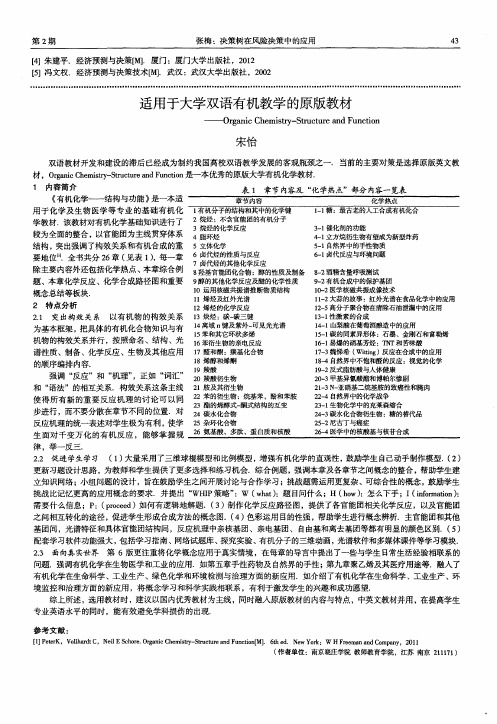
宋怡
双语 教材开发和建设 的滞后 已经成为制 约我 国高校双语教学发展 的客观瓶颈之一. 当前 的主要对策是选择 原版英 文教 材 ,O r g a n i c c h e m i s t r y — s t mc t u r e a n d F u n c t i o n 是一本优 秀的原 版大学 有机化学教材. 1 内容简介 表 1 章节 内容及 t ・ 化学热点”部分 内 容 一览表 《 有机化学—— 结构与功能 》 是 一本适 节 内容 化 学热点 有机分子的结构和其中的化学键 l 一 1 糖 :最古老的人工合成有机化合 用 于化学及 生 物医学 等专 业 的基 础 有机 化 l 学教材.该教材对有机化学基础 知识 进行 了 2 烷烃 :不 舍官 能 团的有 机 分子 较为全面的整合 , 以官 能团为 主线贯 穿体 系 4 脂环 烃 结构 , 突出强调 了构效关 系和有 机合 成的重 5 立体 化学
需要什么信息 ;P : ( p r o c e e d ) 如 何有逻辑地解题.( 3 ) 制作化学 反应路径 图 , 提供 了各 官能 团相关化学反应 ,以及 官能团 之 间相互转化 的途径 , 促进学生形成合成方 法的概念 图. ( 4 ) 色彩运用 目的性强 , 帮助学生进行 概念 辨析 .主官能团和其他 基团间 ,光谱特征 和具体 官能团结 构间 ,反应机理 中亲核基 团、亲 电基 团、 自由基 和离去基 团等都有明显的颜色区别 .( 5 ) 配套学习软件功能强 大 , 包括学习指南 、 网络试题库 、 探究实验 、 有机分子 的三维动画 , 光谱软件和多媒体课件等学习模块. 2 . 3 面向真 实世界 第 6版更 注重将 化学概 念应用 于真实情境 , 在 每章 的导言中提出了一些与学生 日 常生活经验相联系的 问题.强调有机 化学在生 物医学和工业 的应 用.如第五章手 性药物及 自然界的手性 ; 第 九章 聚乙烯及其医疗用途等.融入了 有机化学在生命科学 、 工业生 产 、 绿色化学和环境检测与治理方面的新应用.如介绍 了有机化学在生命科学 、工业生产 、 环 境监控和治理方面的新应用 ,将概念学习和科学 实践 相联 系 ,有利 于激发学生的兴趣 和成 功愿望. 综 上所述 , 选 用教材 时 , 建议 以国 内优秀教材为主线 , 同时融入原版教材 的内容与特点 , 中英 文教材 并用 , 在提 高学生 专业英语水 平的同时 ,能有效避 免学科 损伤 的出现.
化学中英双语全面Review

7.2 metals and water
金属和水反应
metals react with water 金属与水的反应
sodium Na +H2O----NaOH +H2 ( chemical equation 化 学方程式) NaOH(sodium hydrate氢氧化钠) 2Na +2H2O===2NaOH +H2(balanced equation) Only reactive metals, for example, Li Na K Ca Mg, can react with water. 只有非常活泼的金属,比如锂、钠、钾、钙、镁, 能够与水发生反应。
6.5 Inside solids
What are solids like? 固体是什么样子的
A lump of solid contains millions of atoms ,all held together tightly in a regular pattern. 一小块固体通常就含有上百万个原子,所有的原 子之间都以有规律的模式相互紧密结合在一起。
分析化学实验英汉双语教材教学设计
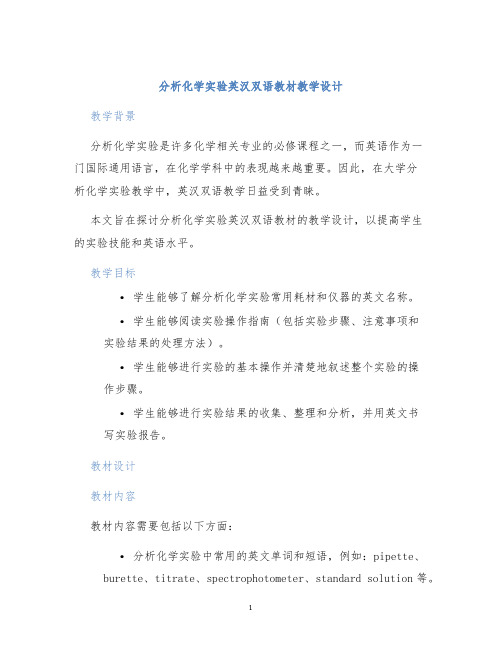
分析化学实验英汉双语教材教学设计教学背景分析化学实验是许多化学相关专业的必修课程之一,而英语作为一门国际通用语言,在化学学科中的表现越来越重要。
因此,在大学分析化学实验教学中,英汉双语教学日益受到青睐。
本文旨在探讨分析化学实验英汉双语教材的教学设计,以提高学生的实验技能和英语水平。
教学目标•学生能够了解分析化学实验常用耗材和仪器的英文名称。
•学生能够阅读实验操作指南(包括实验步骤、注意事项和实验结果的处理方法)。
•学生能够进行实验的基本操作并清楚地叙述整个实验的操作步骤。
•学生能够进行实验结果的收集、整理和分析,并用英文书写实验报告。
教材设计教材内容教材内容需要包括以下方面:•分析化学实验中常用的英文单词和短语,例如:pipette、burette、titrate、spectrophotometer、standard solution等。
•实验操作指南的英汉双语版本,包括实验步骤、注意事项和实验结果处理方法等。
•实验操作中可能会用到的公式、单位和修约规则等英文表达方式。
•实验报告书写中可能会用到的实验设计、数据处理和结果分析方面的英文书写。
教学策略实验教学是一种注重操作技能和实践能力的教学形式,英汉双语实验教学需要重视以下几个方面:教学方法采用“示范-实践-总结”教学法,即先由教师进行实验的示范操作,然后让学生进行实验操作,最后教师总结实验过程中注意事项和操作规则。
英语词汇学习在实验操作中耗材和仪器都由英文命名,教师应在实验前先对这些英文单词和短语进行简单的讲解和示范,以达到学生能够理解和准确使用这些英文词汇的目的。
实验指南翻译教师应按照实验操作指南的步骤按段一段进行翻译,以便于学生理解和查找相关内容。
实验操作指导当学生实验时,教师应给予积极的指导和帮助。
并在学生整理和分析实验结果时及时提醒学生注意文献格式和英文单词的用法问题。
实验结果分析教师应引导学生利用教材中提供的英语词汇,对实验结果进行收集、整理和分析,并用英语书写实验报告。
高中化学校本课程教材(2021年整理)

高中化学校本课程教材(word版可编辑修改)编辑整理:尊敬的读者朋友们:这里是精品文档编辑中心,本文档内容是由我和我的同事精心编辑整理后发布的,发布之前我们对文中内容进行仔细校对,但是难免会有疏漏的地方,但是任然希望(高中化学校本课程教材(word 版可编辑修改))的内容能够给您的工作和学习带来便利。
同时也真诚的希望收到您的建议和反馈,这将是我们进步的源泉,前进的动力。
本文可编辑可修改,如果觉得对您有帮助请收藏以便随时查阅,最后祝您生活愉快业绩进步,以下为高中化学校本课程教材(word版可编辑修改)的全部内容。
高中化学校本课程教材化学实验大埔县家炳第一中学化学组编课程立项说明:一、课程(教材)内容本课程,主要针对高二学生开设,本学期共开设十八个课时(见目录)。
二、课程(教材)组织以及实施方案课程目标包括:1、知识与技能●懂得运用已学化学知识。
如卤素,物质的量浓度等●了解某些各类食物主要成分的营养作用,以及可能的特征反应。
●了解人体中元素的存在形式,知道常量元素与微量元素;●懂得一些生活常识。
2、过程与方法●初步学会运用多种手段查找资料,调查研究,运用比较、分类、归纳、概括等方法主动获取有用信息;●了解食品的主要成分;●了解化学研究的初步方法,知道定性分析与定量分析.●主动与他人进行交流和分享。
3、情感态度与价值观●逐步建立科学的世界观,用一分为二的辩证唯物主义观点看待食物营养对人体健康的影响;●逐步认识化学科学的发展在生活实际中的不可或缺的贡献。
●逐步认识学习科学知识的意义,热爱科学。
本课程的学习方法导航本课题的教学可采用开放式的教学方式,将学生分成四人的小组或八人大组,明确要求每个组按照:课前查资料、做前看资料、动手用知识、做完细思考、课后还可做的程序安排课堂内容。
由学生独立自主完成实验操作,指导学生运用知识,熟练操作。
培养学生处理和获取有用信息的能力。
同时也培养学生的合作意识和语言表达能力。
高中英语校本教材(必修1—必修5)

高中英语校本教材Book1 Unit1 Friendship一、看音标,写单词,并翻译。
1. ['set(ə)l] ______ _____2. [ɪg'nɔː] _______ ________3. [kɑːm] ______ _____4.[kən'sɜːn] _________ _______5. [pæk] _____ _____6.['tiːneɪdʒə] ________ _______7. [rɪ'kʌvə]_______ _____ 8.['sʌfə] _______ ________9. ['greɪtfʊl] ______ _____10.[aʊt'dɔːz] ______ ______11.[ɪn'taɪə] _______ _____ 12.[ɪg'zæk(t)lɪ] ______ _____13.['paʊə] ______ _______ 14.[dɪsə'griː] _____ _______15.['θʌndə] _____ _____ 16.[luːs] _______ __________二、重点短语英汉互译。
1. add up ____________2. calm down ____________3.be concerned about _______4.go through __________5.set down ______________6. on purpose ___________7. at dusk ______________ 8. a series of _________9.将(东西)装箱打包_________ 10. 与……相爱 _________11. 遭受;患病_________ 12. 对……厌烦________三、重点句型。
【高中化学校本课程】《化学与生活》校本教材
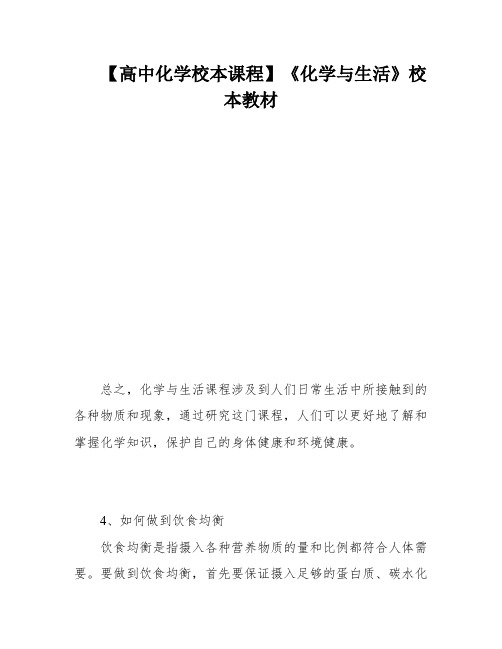
【高中化学校本课程】《化学与生活》校本教材总之,化学与生活课程涉及到人们日常生活中所接触到的各种物质和现象,通过研究这门课程,人们可以更好地了解和掌握化学知识,保护自己的身体健康和环境健康。
4、如何做到饮食均衡饮食均衡是指摄入各种营养物质的量和比例都符合人体需要。
要做到饮食均衡,首先要保证摄入足够的蛋白质、碳水化合物和脂肪。
其次,要摄入足够的维生素和矿物质,这些物质可以通过多吃水果、蔬菜、豆类、全谷类等食物来获得。
此外,还应该注意饮食的多样性,不要只吃某一种食物,而是要尽可能地摄入各种不同的食物。
最后,要控制饮食的总能量摄入,避免过度摄入高热量的食物,以免导致肥胖和相关疾病的发生。
不足会导致夜盲症和角膜干燥症;维生素D不足会导致佝偻病;缺铁会导致贫血;缺钙会影响骨骼发育和牙齿健康;缺锌会影响免疫功能和生殖发育。
因此,青少年在饮食中应该保证摄入各种营养素的平衡,多吃水果、蔬菜、全谷类、豆类及其制品、瘦肉、鱼类等食物,同时减少高热量、高脂肪、高糖分的食物摄入,以保证身体健康和正常发育。
水是生活必需品,但自来水中含有致病微生物,需要消毒。
氯化消毒是一种可靠、成本低的方法,可以有效控制肠道传染病。
消毒后的自来水仍然含有有机化合物和有毒物质,需要注意直接饮用可能产生的风险。
喝水也是一门学问,不能仅仅视为解渴。
在日常生活中,不能饮用生水和老化水,因为生水可能含有对人体有害的细菌、病毒和寄生虫,而老化水中的有毒物质会随着时间的增加而增加。
长期饮用老化水可能会影响人体细胞的新陈代谢,加速衰老,甚至增加患癌症的风险。
健康的饮用水应该是硬度适中、溶解性固体相对较多、偏碱性的水。
硬水可以束缚住有害成分,降低它们的被吸收;矿物质也可以提供阻止毒物发挥有害作用所需的养分。
专家推荐青少年喝茶水,茶水中含有丰富的维生素、氨基酸、茶多酚、黄酮、糖、蛋白质、矿物质等多种物质,具有清心提神、除烦消炎、生津解渴、防治多种疾病的功能。
化学专业课程中英文对照
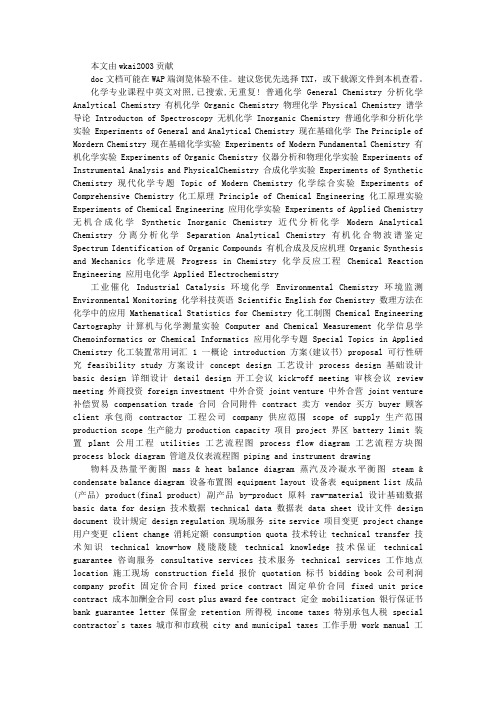
本文由wkai2003贡献doc文档可能在WAP端浏览体验不佳。
建议您优先选择TXT,或下载源文件到本机查看。
化学专业课程中英文对照,已搜索,无重复! 普通化学 General Chemistry 分析化学Analytical Chemistry 有机化学 Organic Chemistry 物理化学 Physical Chemistry 谱学导论 Introducton of Spectroscopy 无机化学 Inorganic Chemistry 普通化学和分析化学实验 Experiments of General and Analytical Chemistry 现在基础化学 The Principle of Mordern Chemistry 现在基础化学实验 Experiments of Modern Fundamental Chemistry 有机化学实验 Experiments of Organic Chemistry 仪器分析和物理化学实验 Experiments of Instrumental Analysis and PhysicalChemistry 合成化学实验 Experiments of Synthetic Chemistry 现代化学专题 Topic of Modern Chemistry 化学综合实验 Experiments of Comprehensive Chemistry 化工原理 Principle of Chemical Engineering 化工原理实验Experiments of Chemical Engineering 应用化学实验 Experiments of Applied Chemistry 无机合成化学Synthetic Inorganic Chemistry 近代分析化学Modern Analytical Chemistry 分离分析化学Separation Analytical Chemistry 有机化合物波谱鉴定Spectrum Identification of Organic Compounds 有机合成及反应机理 Organic Synthesis and Mechanics 化学进展Progress in Chemistry 化学反应工程Chemical Reaction Engineering 应用电化学 Applied Electrochemistry工业催化Industrial Catalysis 环境化学Environmental Chemistry 环境监测Environmental Monitoring 化学科技英语 Scientific English for Chemistry 数理方法在化学中的应用 Mathematical Statistics for Chemistry 化工制图 Chemical Engineering Cartography 计算机与化学测量实验 Computer and Chemical Measurement 化学信息学Chemoinformatics or Chemical Informatics 应用化学专题 Special Topics in Applied Chemistry 化工装置常用词汇 1 一概论 introduction 方案(建议书) proposal 可行性研究 feasibility study 方案设计 concept design 工艺设计 process design 基础设计basic design 详细设计 detail design 开工会议 kick-off meeting 审核会议 review meeting 外商投资 foreign investment 中外合资 joint venture 中外合营 joint venture 补偿贸易 compensation trade 合同合同附件 contract 卖方 vendor 买方 buyer 顾客client 承包商 contractor 工程公司 company 供应范围 scope of supply 生产范围production scope 生产能力 production capacity 项目 project 界区 battery limit 装置plant 公用工程utilities 工艺流程图process flow diagram 工艺流程方块图process block diagram 管道及仪表流程图 piping and instrument drawing 物料及热量平衡图 mass & heat balance diagram 蒸汽及冷凝水平衡图 steam & condensate balance diagram 设备布置图 equipment layout 设备表 equipment list 成品(产品) product(final product) 副产品 by-product 原料 raw-material 设计基础数据basic data for design 技术数据 technical data 数据表 data sheet 设计文件 design document 设计规定 design regulation 现场服务 site service 项目变更 project change 用户变更 client change 消耗定额 consumption quota 技术转让 technical transfer 技术知识technical know-how 牋牋牋牋technical knowledge 技术保证technical guarantee 咨询服务 consultative services 技术服务 technical services 工作地点location 施工现场 construction field 报价 quotation 标书 bidding book 公司利润company profit 固定价合同 fixed price contract 固定单价合同 fixed unit price contract 成本加酬金合同 cost plus award fee contract 定金 mobilization 银行保证书bank guarantee letter 保留金 retention 所得税 income taxes 特别承包人税 special contractor's taxes 城市和市政税 city and municipal taxes 工作手册 work manual 工作流程图 work flow diagram 质量保证程序 QA/QC procedures 采购计划 procurement plan 施工计划 construction plan 施工进度 construction schedule 项目实施计划 project execution plan 项目协调程序 project coordination procedure项目总进度计划 project master schedule 设计网络计划 engineering network logic 项目质量保证 project quality assurance 项目质量控制 project quality control 采购procurement 采购周期 procurement period 会签 the squad check 计算书 calculation sheets 询价inquiry 检验inspection 运输transportation 开车start up / commission 验收 inspection & acceptance 校核 check 审核 review 审定 approve 版次version 部门 department 专业 specialty 项目号 project number 图号 drawing number 目录 contents 序言 foreword 章 chapter 节 section 项 item MR material requisition SPEC engineering specification DATA SHEET(技术表) technical data sheet TBA(技术评标) technical bid analysis PDP preliminary design package PM (项目经理) project manager LDE(专业负责人lead discipline engineer MRQ(材料询价单) Material requisition for quotation MRP(材料采购单) material requisition for purchase BEP(基础工程设计包) basic engineering package P&ID(管道及仪表流程图) piping and instrument drawing(diagram) PFD process flow diagram NNF normally no flow FO failure open FC failure close C/S/A civil/structure/architecture DDP(详细设计阶段) detail design phase化工装置词汇二. 工艺流程连续过程 continuous process 间歇过程 batch process 工艺叙述process description 工艺特点process feature 操作operation 反应reaction 副反应 side reaction 絮凝 flocculation 浮洗 flotation 倾析 decantation 催化反应catalytical reaction 萃取extraction 中和neutralization 水解hydrolysis 过滤filtration 干燥drying 还原reduction 氧化oxidation 氢化hydrogenation 分解decomposition 离解dissociation 合成synthetics 吸收absorption 吸附 adsorption 解吸 desorption 结晶 crystallization 溶解 solution 调节 modulate 控制 control 悬浮 suspension 循环 circulation 再生 regeneration 再活化 reactivation 沥取 leaching 破碎 crushing 煅烧 caloination 沉降 sedimentation 沉淀 precipitation 气化 gasification 冷冻 refrigeration固化,结晶 solidification 包装 package 升华 sublimation 燃烧 combustion 引烧ignition 蒸馏 distillation 碳化 carbonization 压缩 compression 三,化学物质及特性固体 solid 液体 liquid 气体 gas 化合物 compound 混合物 mixture 粉 powder 片状粉未 flake 小粒 granule 结晶 crystal 乳化物 emulsion 氧化物 oxidizing agent 还原剂reducing agent 有机物 organic material 真空 vacuum 母液 master liquor 富液 rich liquor 贫液 lean liquor 萃出物 extract 萃余物 raffinate 絮凝剂 flocculants 冷冻盐水 brine 酸度 acidity 浓度 concentration 碱度 alkalinity 溶解度 solubility 凝固点solidificalion point 沸点boiling point 熔点melting point 蒸发率evaporation rate 粘度 viscosity 吸水的 water absorbent(a) 无水的 anhydrous(a) 外观 appearance 无色的 colorless(a)透明的transparent(a) 半透明的translucent 密度density 比重specific gravity 催化剂catalyst 燃烧combustion 引燃ignition 自然点self-ignition temperature 可燃气体combustible gas 可燃液体inflammable liquid 易燃液体volatile liquid 爆炸混合物explosive mixture 爆炸性环境explosive atmosphere(environment) 爆炸极限 explosive concentration limit 废水 waste water 废液waste liquid 废气off-gas 噪声noise pollution 成分composition 挠度deflection 力和力矩force and moment 弯矩bending moment 应力-应变曲线stress-strain diagram 百分比 percentage 环境温度 ambient temperature 工作温度operating 设计温度 design temperature(pressure) 相对湿度 RH=relative humidity 油渣,淤泥 sludge 杂质 impurity 四,化工设备泵 pump 轴流泵 axial flow pump 真空泵vacuum pump 屏蔽泵 canned pump 柱塞泵 plunger pump 涡轮泵 turbine pump 涡流泵vortex pump 离心泵 centrifugal pump 喷射泵 jet pump 转子泵 rotary pump 管道泵inline pump 双作用往复泵 double action reciprocating pump计量泵 metering pump 深井泵 deep well pump 齿轮泵 gear pump 手摇泵 hand(wobble) pump 螺杆泵 screw (spiral) pump 潜水泵 submersible pump 斜转子泵 inclined rotor pump 封闭式电磁泵 hermetically sealed magnetic drive pump 气升泵 air-lift-pump 轴承 bearing 叶轮 impeller 虹吸管 siphon 高压容器 high pressure vessel 焚化炉incinerator 火焰清除器 flame arrester 工业炉 furnace 烧嘴 burner 锅炉 boiler 回转窑 rotary kiln 加热器 heater 电加热器 electric heater 冷却器 cooler 冷凝器condenser 换热器 heat exchanger 反应器 reactor 蒸馏釜 still 搅拌器 agitator 混合器 mixer 静态混合器 static mixers 管道混合器 line mixers 混合槽 mixing tanks 破碎机 crusher 磨碎机 grinder 研磨机 pulverizer 球磨机 ballmill 过滤器 filter 分离器separator 干燥器drier 翅片fins 烟囱stack 火炬flare 筛子screen 煅烧窑calciner 倾析器 decanter蒸发器 evaporator 再沸器 reboiler 萃取器 extractor 离心机 centrifuger 吸附(收)器adsorber 结晶器crystallizer 电解槽electrolyzer 电除尘器electric precipitator 洗涤器 scrubber 消石灰器 slaker 料仓 bin 料斗 hopper 加料器 feeder 增稠器 thickener 澄清器 clarifier 分级器 classifier 浮洗器 flocculator 废液池sump 喷射器 ejector 喷头 sprayer 成套设备 package unit 仪器设备 apparatus 附属设备 accessory 旋转式压缩机 rotary compressor 往复式压缩机 reciprocating compressor 水环式压缩机 nash compressor 螺杆式压缩机 helical screw compressor 离心式压缩机centrifugal compressor 多级压缩机 mutiple stages compressor 固定床反应器 fixed bed reactor 流化床反应器 fluidized bed reactor 管式反应器 tubular reactor 列管式换热器tubular heat exchanger 螺旋板式换热器spiral plate heat exchanger 萃取塔extraction column 板式塔 plate column 填料塔 packed column 洗涤塔 scrubber 吸收塔absorber 冷却塔 cooling tower 精馏塔 fractionating tower 汽提塔 stripper 再生塔regenerator 造粒塔 prill tower塔附件 tower accessories 液体分配(布)器 liquid distributor 填料支持板 support plate 定距管 spacer 降液管 downcomer 升气管 chimney 顶(底)层塔盘 top (bottom) tray 挡板 baffle 抽出口 draw nozzle 溢流堰 weir 泡罩 bubble cap 筛板 sieve plate 浮阀 float valve 除沫器 demister pad 塔裙座 skirt 椭圆封头 elliptical head 高位槽head tank 中间槽 intermediate tank 加料槽 feed tank 补给槽 make-up tank 计量槽measuring tank 电解槽 cell 溜槽 chute 收集槽 collecting tank 液滴分离器 knockout drum 稀释罐 thinning tank 缓冲罐 surge drum 回流罐 reflux drum 闪蒸罐 flash drum 浮顶罐 floating roof tank 内浮顶罐 covered floating roof tank 球罐 spheroid 气柜gas holder 湿式气柜 wet gas-holder 干式气柜 dry gas-holder 螺旋式气柜 helical gas-holder 星型放料器,旋转阀 rotary valve 抽滤器 mutche filter 压滤器 filter press 压滤机 pressure filter 板框压滤器 plate-and-fram filter press 转鼓过滤器rotary drum filter 带式过滤器 belt filter 翻盘式过滤器袋滤器 bag filter 旋风分离器 cyclone separator 盘式干燥箱 compartment traydrier 真空干燥器 vacuum drier 隧道式干燥器 tunnel drier 回转干燥器 rotary drier 穿流循环干燥器through circulation drier 喷雾干燥器spray drier 气流干燥器pneumatic conveyor drier 圆盘式加料器 dish feeder 螺旋式加料器 screw feeder 颚式破碎机 jaw crusher 回转破碎机 gyratory crusher 滚洞破碎机 roll crusher 锤式破碎机hammer crusher 冲击破碎机 rotor impact breaker 气流喷射粉碎机 jet pulverizer 棍磨机 rod mill 雷蒙机 raymond mill 锤磨机 hammer mill 辊磨机 roller mill 振动筛vibrating screen 回转筛 rotary screen 风机 fan 罗茨鼓风机 root's blower 起重机crane 桥式起重机 bridge crane 电动葫芦 motor hoist 发电机 generator 电动机 motor 汽轮机 steam turbine 五,管道工程 piping engineering 1 阀门 valve 阀杆 stem 内螺纹阀杆 inside screw 阀座 valve seat (body seat) 阀座环,密封圈 sealing ring 阀芯(包括密封圈,杆等)trim 阀盘 disc 阀体 body 阀盖 bonnet 手轮 hand wheel 手柄 hand level (handle)压盖 gland 闸阀 gate valve 平行双闸板 double disc parallel seat 楔形单闸板split wedge 截止阀 globe valve 节流阀 throttle valve 针阀 needle valve 角阀(角式截止阀)angle valve Y 型阀(截止阀)Y-valve(Y-body globe valve) 球阀 ball valve 三通球阀 3-way ball valve 蝶阀 butterfly valve 对夹式(薄片型)wafer type 偏心阀板蝶阀offset disc (eccentric) butterfly valve 斜阀盘蝶阀 canted disc butterfly valve 连杆式蝶阀 link butterfly valve 止回式蝶阀 combined non-return butterfly valve 柱塞阀 piston type valve 旋塞阀 plug valve 三通旋塞阀 three-way plug valve 四通旋塞阀four-way plug valve 旋塞 cock 衬套旋塞 sleeve cock 隔膜阀 diaphragm valve 橡胶衬里隔膜阀 rubber lined diaphragm valve 直通式隔膜阀 straight way diaphragm valve 夹紧式胶管阀 pinch valve 止回阀 check valve 升降式止回阀 lift check valve 旋启式止回阀 swing check valve 落球式止回阀 ball check valve 弹簧球式止回阀 spring ball check valve 底阀 foot valve 切断式止回阀 stop check valve 活塞式止回阀 piston check valve 翻板止回阀 flap check valve 蝶式止回阀 butterfly check valve 安全泄气阀 safety[SV] 安全泄放阀 relief valve[RV] 安全泄压阀 safety relief valve 杠杆重锤式 lever and weight type 罐底排污阀 flush-bottom tank valve 波纹管密封阀 bellow sealed valve 电磁阀 solenoid (operated) valve电动阀 electrically(electric-motor)operated valve 气动阀 pneumatic operated valve 低温用阀cryogenic service valve 蒸汽疏水阀steam trap 机械式疏水阀mechanical trap 浮桶式疏水阀 open (top) bucket trap 浮球式疏水阀 float trap 倒吊桶式疏水阀 inverted bucket trap 自由浮球式疏水阀 loose float trap 恒温式疏水阀thermostatic trap 压力平衡式恒温疏水阀 balanced pressure thermostatic trap 热动力式疏水阀 thermodynamic trap 脉冲式蒸汽疏水阀 impulse steam trap 放汽阀(自动放汽阀)(automatic) air vent valve 换向阀 diverting (reversing) valve 呼吸阀 breather valve 减压阀 pressure reducing valve 控制阀 control valve 执行机构 actuator 差压调节阀 differential pressure regulating valve 切断阀 block (shut-off, stop) valve 调节阀 regulating valve 快开阀 quick opening valve 快闭阀 quick closing valve 隔断阀 isolating valve 三通阀 three way valve 夹套阀 jacketed valve 非旋转式阀non-rotary valve 2 管子,管件,法兰管子 pipe(按标准制造的配管用管) tube(不按标准规格制造的其它用管) 钢管 steel pipe 铸铁管 cast iron pipe 衬里管 lined pipe 复合管clad pipe 碳钢管carbon steel[C.S.]pipe 合金钢管alloy steel pipe 不锈钢管stainless steel[S.S.]pipe 奥氏体不锈钢管 austenitic stainless steel pipe 铁合金钢管 ferritic alloy steel pipe 轧制钢管 wrought-steel pipe 锻铁管 wrought-iron pipe无缝钢管 seamless[SMLS] steel pipe 焊接钢管 welded steel pipe电阻焊钢管electric-resistance-welded steel pipe 电熔(弧)焊钢板卷管electric-fusion(arc)-welded steel-plate pipe 螺旋焊接钢管 spiral welded steel pipe 镀锌钢管 galvanized steel pipe 排污阀 blowdown valve 集液排放阀 drip valve 排液阀drain valve 放空阀 vent valve 卸载阀 unloading valve 排出阀 discharge valve 吸入阀 suction valve 取样阀 sampling valve 手动阀 hand operated(manually-operated) valve (水)龙头 bibb;bib;faucet 抽出液阀(小阀)bleed valve 旁路阀 by-pass valve 软管阀 hose valve 混合阀 mixing valve 破真空阀 vacuum breaker 冲洗阀 flush valve 根部阀 root (primary, header) valve 水煤气钢管 water-gas steel pipe 塑料管 plastic pipe 玻璃管 glass tube 橡胶管 rubber tube 壁厚 wall thickness[WT] 壁厚系列号schedule number[SCH.NO.] 加厚的,加强的 extra heavy (strong) 双倍加厚的,双倍加强的double extra heavy (strong) 弯头 elbow 异径弯头 reducing elbow 长半径弯头 long radius elbow 短半径弯头 short radius elbow 长半径 180°弯头 long radius return 短半径180°弯头short radius return 三通tee 异径三通 reducing tee 等径三通straight tee 带支座三通 base tee 45°斜三通 45°lateral Y 型三通 true"Y" 四通cross异径管 reducer 同心异径管 concentric reducer 偏心异径管 eccentric reducer 管接头 coupling;full coupling 活接头 union 短管 nipple 预制弯管 fabricated pipe bend U 型弯管"U"bend 法兰端 flanged end 万向接头 universal joint 对焊的 butt welded[BW] 螺纹的 threaded[THD] 承插焊的 socket welded[SW] 法兰 flange[FLG] 整体管法兰 integral pipe flange 钢管法兰 steel pipe flange 螺纹法兰 threaded flange 滑套法兰 slip-on flange 平焊法兰 slip-on-welding flange 承插焊法兰 socket welding flange 松套法兰 lap joint flange[LJF] 对焊法兰 weld neck flange[WNF] 法兰盖 blind flange;blind 异径法兰 reducing flange 压力级 pressure rating(class) 突面 raised face[RF] 凸面 male face 凹面 female face 全平面;满平面 flat face;full face[FF] 3.管道特殊件 piping speciality 粗滤器 strainer 过滤器 filter 临时过滤器 temporary strainer(cone type) Y 型过滤器 Y-type strainer T 型过滤器 T-type strainer 永久过滤器 permanent filter 洗眼器及淋浴器 eye washer and shower 视镜 sight glass 阻火器 flame arrester 喷咀;喷头 spray nozzle 喷射器 ejector 取样冷却器 sample cooler 消音器 silencer膨胀节 expansion joint 波纹膨胀节 bellow 补偿器 compensator 软管接头 hose connection[HC] 快速接头 quick coupling 金属软管 metal hose 橡胶管 rubber hose 挠性管 flexible tube 特殊法兰 special flange 漏斗 funnel 8 字盲板 spectacle (figure 8) blind 爆破板rupture disk 4,其它材料碳素钢carbon steel [C.S.] 不锈钢stainless steel[S.S.] 铸铁 cast iron[C.I.] 铝 aluminum 铜,紫铜 copper 钛 titanium 抗拉强度 tensile strength 非金属材料 non-metallic material 塑料 plastic 陶瓷ceramic 搪瓷 porcelain enamel 玻璃 glass 橡胶 rubber 垫片 gasket[GSKT] 平垫片flat gasket 填料 packing 型钢 shaped steel 角钢 angle steel 槽钢 channel 工字钢I-beam 宽缘工字钢或 H 钢 wide flanged beam 扁钢 flat bar 圆钢 round steel; rod 钢带 strap steel 网络钢板 checkered plate 材料表 bill of material[BOM] 材料统计material take-off[MTO] 散装材料 bulk material 综合管道材料表 consolidated piping material summary sheet[CPMSS]汇总表summary sheet 5.设备布置及管道设计中心线center line 装置边界boundary limit[BL] 区界 area limit 设备布置 equipment arrangement (layout);plotplan 标高,立面 elevation[EL] 支撑点 point of support[POS] 工厂北向 plant north 方位 orientation 危险区 hazardous area classification 净正吸入压头 net positive suction head 绝对标高 absolute elevation 坐标 coordinate 管道研究 piping study 管道布置平面 piping arrangement plan[PAP] 管道布置 piping assembly; layout 详图detail "X"视图 view "X" "A-A" 剖视 section "A-A" 轴测图 isometric drawing 索引图key plan 管道及仪表流程图 piping and instrument diagram[P&ID] 管口表 list of nozzles 地上管道 above ground piping 地下管道 under ground piping 管线号 line number 总管 header; manifold 旁路 by pass 常开 normally open 常闭 normally closed 取样接口 sampling connection 伴热管 tracing pipe 蒸汽伴热 steam tracing 热水伴热hot-water tracing 电伴热 electrical tracing 夹套管 jacketed line 全夹套管 full jacketed 比例 scale 图 figure 草图 sketch 图例 legend符号 symbol 件号 part no1。
应用化学专业英语第二版万有志主编版主要课文翻译

1、化学的起源化学可以被广泛的定义为分子的科学和它们之间的转换。
和数学不同,化学在人类之前。
我们的星球(地球)上的生命和人类的外观很可能是化学进程的具体结果。
化学过程从历史的开端一直到现在都出现在人们的生活中。
最初,这些过程不在我们的掌控之中,例如,果汁的发酵,肉和鱼的腐烂,木头的燃烧。
后来我们学着去控制化学进程使用它来生产不同的产品,比如食物,金属,陶瓷和皮革。
在化学的发展上,主要区分为四个阶段:史前化学,希腊化学,炼金术,科学化学。
早期的化学很明显是被人们实际需要所激发的。
火的发现提供了史前人类开始控制化学反应的一次机会。
他们合成一些黄铜,青铜和其他易得材料的物品。
因为人类早期对化学过程的应用早于记载,所以没有关于它们化学技能的记录。
唯一可以判断它们化学能力的是考古的发现和不同的人造品。
正如早期数学发展一样,实际需要影响着化学的发展。
但是化学和数学在这个阶段很可能没有关系。
即使有,也没有记录来确定这些。
希腊化学主要建立在推测的基础上而不是在实验的基础上。
这是古希腊所有科学的普遍特征。
古希腊科学家实际上是哲学家,所以希腊对思考如此感兴趣盛于实验也就不足为奇了。
事实上他们很少做思考之外的实验。
这对数学是一个好的方法但是却不是对于物理,化学和生物科学。
然而,希腊人思考了许多关于自然和物质结构,他们可以被看作早期化学理论的创造者。
希腊引进了元素的概念总共提出了四种元素。
Thalesren 认为所有的东西来自一种基本的物质,就是水。
Anaximenes,接受了元素的概念,但他认为来单独的元素自于空气中的物质。
Heraclitus,认为宇宙的基本的特点是不断变化的,把火作为永久变化的元素。
Empedocles摒弃了了单独元素的概念并引进了四种元素:水,空气,火和土,他也因为他的实验证明了空气是一种物质结构而出名。
火这种元素最早被柏拉图引用他猜测每种元素的粒子有特定的形体,尽管这种粒子太小以至于看不见。
因此,火的最小的粒子有规则的四面体结构,空气是八面体,水是二十面体,土是立方体(主要是六面体)。
Lesson-2--Organic-Chemistry-翻译
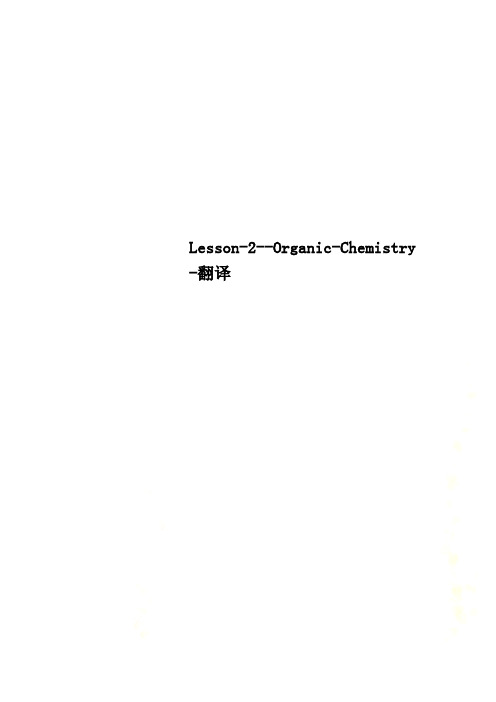
Lesson-2--Organic-Chemistry -翻译新编化学化工专业英语翻译Lesson 2 Organic Chemistry The nature of Organic Chemistry has changed greatly since 1828. Before that time the scientific philosophy known as “Vitalism” maintained that Organic Chemistry was the chemistry of living systems. It maintained that organic compounds could only be produced within living matter while inorganic compounds were synthesized from non-living matter. Even the word “organic” comes from the same root as the word “organism” or “organ”. Howeve r people like Professor Wohler beginning in 1828 determined that it was indeed possible to synthesize organic compounds from those compounds that were considered inorganic. One of the first organic compounds synthesized from basically inorganic compounds was the compound Urea which is a metabolic product of urine. It was synthesized from Ammonium Cyanate considered a compound produced outside of living matter and therefore considered inorganic. Since then many millions of Organic compounds have been synthes ized “in vitro” in other words outside living tissue.1 Structural formulasThe building block of structural organic chemistry is the2 Organic nomenclatureOrganic nomenclature is the system established for naming and grouping organic compounds.Formally, rules established by the International Union of Pure and Applied Chemistry (known as IUPAC nomenclature) are authoritative for the names of organic compounds, but in practice, a number of simply-applied rules can allow one to use and understand the names of many organic compounds.For many compounds, naming can begin by determining the name of the parent hydrocarbon and by identifying any functional groups in the molecule that distinguish it from the parent hydrocarbon. The numbering of the parent alkane is used, as modified, if necessary, by application of the Cahn-Ingold-Prelog priority(CIP priority) rules in the case that ambiguity remains after consideration of the structure of the parent hydrocarbon alone. The name of the parent hydrocarbon is modified by the application of the highest-priority functional group suffix, with the remaining functional groups indicated by numbered prefixes, appearing in thename in alphabetical order from first to last.In many cases, lack of rigor in applying all such nomenclature rules still yields a name that is intelligible-the aim, of course, being to avoid any ambiguity in terms of what substance is being discussed.For instance, strict application of CIP priority to the naming of the compound-NH2CH2CH2OH would render the name as 2-aminoethanol,which is preferred. However, the name 2-hydroxyethanamine unambiguously refers to the same compound.How the name was constructed:(1)There are two carbons in the main chain; this gives the root name “eth”.(2)Since the carbons are singly-bonded, the suffix begins with “an”.(3)The two functional groups are an alcohol (OH) and an amine (NH2). The alcohol has the higher atomic number, and takes priority over the amine. The suffix for an alcohol ends in “ol”, so th at the suffix is “anol”.(4)The amine group is not on the carbon with the OH (the #1 carbon), but one carbon over (the #2 carbon); therefore we indicate its presence with the prefix “2-amino”.(5)Putting together the prefix, the root and the suffix, we get “2-aminoethanol”.There is also an older naming system for organic compoundsknown as common nomenclature , which is often used for simple, well-known compounds, and also for complex compounds whose IUPAC names are too complex for everyday use.Simplified molecular input line entry specification (SMILES) strings are commonly used to describe organic compounds, and as such are a form of“naming”them.3 Functional groupsFunctional groups are groups of atoms that confer similar properties onto otherwise dissimilar molecules. Carbon, nitrogen, oxygen, hydrogen, and phosphorus are a few of the elements involved in forming functional groups. Carbon can make four bonds. Nitrogen makes three, oxygen two, and hydrogen one.译文:第二课有机化学自从1828年以来,有机化学的性质发生了很大变化。
- 1、下载文档前请自行甄别文档内容的完整性,平台不提供额外的编辑、内容补充、找答案等附加服务。
- 2、"仅部分预览"的文档,不可在线预览部分如存在完整性等问题,可反馈申请退款(可完整预览的文档不适用该条件!)。
- 3、如文档侵犯您的权益,请联系客服反馈,我们会尽快为您处理(人工客服工作时间:9:00-18:30)。
双语和双语教学简介双语的英文是“Bilingual”。
根据英国著名的朗曼出版社出版的《朗曼应用语言学词典》所给的定义是:A person who knows and uses two languages.In everyday use the word bilingual usually means a person who speaks, reads, or understands twolanguages equally well (a balanced bilingual), but a bilingual person usually has a better knowledge ofone language than of the other.For example, he / she may:a) Be able to read and write in only one languageb) Use each language in different types of situation, eg. one language at home and the other atwork.c) Use each language for different communicative purposes, eg. one language for talking aboutschool life and the other for talking about personal feeling一个能运用两种语言的人。
在他的日常生活中能将一门外语和本族语基本等同地运用于听、说、读、写,当然他的母语语言知识和能力通常是大于第二语言的。
举例来说:他/她可能:A) 使用一种语言来读和写;而用另一种语言来听,说。
B) 在不同的场合下使用不同的语言,如在家使用一种语言,在工作单位使用另一种语言。
C) 在不同的交际需要下使用不同的语言,如在谈论学校生活时使用一种语言,而用另一种语言谈论个人情感。
“双语教学”的定义根据英国著名的朗曼出版社出版的《朗曼应用语言学词典》所给的定义是:The use of a second or foreign language in school for the teaching of content subjects.Bilingual education programs may be of different types and include:a) the use of a single school language which is not the child’s home language. This is sometimes called an immersion program.home language when the child enters school but later a gradual change tob) The use of the child’sthe use of the use of the school language for teaching some subjects and the home language forteaching others. This is sometimes called maintenance bilingual education.c) The part ial or total use of the child’s home language when the child enters school, and a later change to the use of the school language only. This is sometimes called transitional bilingual education.能在学校里使用第二语言或外语进行各门学科的教学。
“双语教学”项目可以有不同的形式,包括:A) 学校使用一种不是学生在家使用的语言进行教学。
这种模式称之为:浸入型双语教学。
B) 学生刚进入学校时使用本族语,然后逐渐地使用第二语言进行部分学科的教学,其它学科仍使用母语教学。
这种模式称之为:保持型双语教学。
C) 学生进入学校以后部分或全部使用母语,然后逐步转变为只使用第二语言进行教学。
这种模式称之为:过渡型双语教学。
简言之,“双语”和“双语教学”的界定是:将学生的外语或第二语言,通过教学和环境,经过若干阶段的训练,使之能代替,或接近母语的表达水平。
在中国,双语教学是指除汉语外,用一门外语作为课堂主要用语进行学科教学,目前绝大部分是用英语。
它要求用正确流利的英语进行知识的讲解,但不绝对排除汉语,避免由于语言滞后造成学生的思维障碍;教师应利用非语言行为,直观、形象地提示和帮助学生理解教学内容,以降低学生在英语理解上的难度。
中国不象新加坡、加拿大、印度是一个双语国家,语言环境并不是中外并重,所以中国的双语教学环境决定了它的目的性,属于“外语”教学范畴,而不是“第二语言”的教学范畴。
中国的双语教学只能是上述界定中的“保持型双语教学”。
诺贝尔奖是以瑞典著名化学家、硝化甘油炸药发明人阿尔弗雷德·贝恩哈德·诺贝尔(1833-1896) Alfred Bernhard NobelAlfred Bernhard Nobel, founder of the Nobel Prizes and inventor of dynamite and other powerful explosive, was born in Stockholm, Sweden, on October 21, 1833. His father, Immanuel, was an inventor and engineer who made munitions (军火) and explosives. Most of Alfred's time was spent in Paris, where he studied chemistry.In 1867 Alfred invented dynamite. Eight years later he produced an even more powerful explosive called blasting gelatin (爆炸胶). Duringhis lifetime Nobel took out more than 300 patents.At his death in 1896 Nobel left $9,200,000 to set up a fund for the Nobel Prizes.The Nobel Prizes are given each year for the most important work in six categories: physics, chemistry, physiology or medicine, literature, peace, and economics. The economics award was established in 1969. The prizes averaged about $40,000 each.Four institutions award the prizes. Sweden's Royal Academy of Sciences give the awards in physics, chemistry, and economics. The Royal Caroline Medico-Surgical Institute (皇家卡罗林医学外科研究院) awards the prize in physiology or medicine. The Swedish Academy awards the prize in literature. A committee of the Norwegian parliament gives the prize for peace.A committee selects the people most deserving of the awards. The prize-awarding institutions make the final selections, which are announced each November. Presentation ceremonies are held on December 10, the anniversary of Nobel's death. The peace prize is awarded in Oslo, Norway. The other prizes are presented in Stockholm,Sweden. Most people consider that winning the Nobel Prize is the highest honor that can be achieved in certain particular fields of work.Nobel Prizes in Chemistry1901Jacobus Henricus van 't Hoff (Netherlands, 1852-08-30 - 1911-03-01)Discovery of the laws of chemical dynamics and of the osmotic pressure insolutions1994George A. Olah (USA, *1927)Carbocations1995Paul Crutzen (Netherlands, *1933)Mario Molina (Mexico, *1943)Frank Sherwood Rowland (USA, *1927)for their work in atmospheric chemistry, particularly concerning the formation and decomposition of ozone1996Robert F. Curl, Jr. (USA, *1933)Sir Harold W. Kroto (United Kingdom, *1939)Richard E. Smalley (USA, *1943)for their discovery of fullerenes1997Paul D. Boyer (USA, *1918)John E. Walker (United Kingdom, *1941)for their elucidation of the enzymatic mechanism underlying the synthesis ofadenosine triphosphate (ATP)Jens C. Skou (Denmark, *1918)for the first discovery of an ion-transporting enzyme, Na+, K+-ATPase1998Walter Kohn (USA, *1923)John A. Pople (United Kingdom/USA, *1925)to Walter Kohn for his development of the density-functional theory and to John Pople for his development of computational methods in quantum chemistry(GAUSSIAN computer programs)1999Ahmed H. Zewail (USA, Egypt, *1946)for his studies of the transition states of chemical reactions using femtosecond spectroscopy2000Alan J. Heeger (USA, *1936)Alan G. MacDiarmid (USA, *1927)Hideki Shirakawa (Japan, *1936)for the discovery and development of conductive polymers2001William S. Knowles (USA, *1917)Ryoji Noyori (Japan, *1938)for their work on chirally catalysed hydrogenation reactionsK. Barry Sharpless (USA, *1941)for his work on chirally catalysed oxidation reactions2002John B. Fenn (USA, *1917)Koichi Tanaka (Japan, *1959)for their development of soft desorption ionisation methods for massspectrometric analyses of biological macromoleculesKurt Wüthrich (Switzerland, *1938)for his development of nuclear magnetic resonance spectroscopy for determining the three-dimensional structure of biological macromolecules in solution2003Peter Agre and Roderick MacKinnon (both U.S.) for studies on channels in cellwalls近10年来的诺贝尔化学奖与高考试题集锦随着知识经济的兴起,21世纪综合国力竞争的焦点是高科技领域,是尖端人才的竞争。
